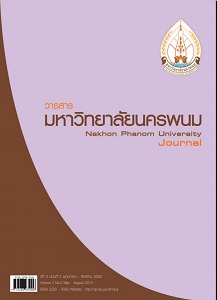ความคาดหวังและความพึงพอใจของประชาชนที่มีต่อนโยบายการพัฒนา ของเทศบาลเมืองนครพนม จังหวัดนครพนม
Main Article Content
Abstract
การวิจัยครั้งนี้มีวัตถุประสงค์เพื่อ 1) ศึกษาความคาดหวังของประชาชนที่มีต่อนโยบายการพัฒนาของเทศบาลเมืองนครพนม โดยจำแนกตามอายุและอาชีพ 2) ศึกษาความพึงพอใจของประชาชนที่มีต่อนโยบายการพัฒนาของเทศบาลเมืองนครพนม โดยจำแนก ตามอายุและอาชีพ 3) เพื่อเปรียบเทียบความคาดหวังของประชาชนที่มีต่อนโยบายการพัฒนาของเทศบาลเมืองนครพนม โดยจำแนก ตามอายุและอาชีพ 4) เปรียบเทียบความพึงพอใจของประชาชนที่มีต่อนโยบายการพัฒนาของเทศบาลเมืองนครพนม โดยจำแนกตาม อายุและอาชีพ 5) ศึกษาความสัมพันธ์ระหว่างความคาดหวังและความพึงพอใจของประชาชนที่มีต่อนโยบายการพัฒนาของเทศบาลเมือง นครพนม กลุ่มตัวอย่างที่ใช้ในการวิจัย ประกอบด้วย ประชาชนในเขตเทศบาลเมืองนครพนม จำนวน 377 คน กำหนดขนาดของกลุ่ม ตัวอย่าง โดยใช้ตารางของเครจซี่และมอร์แกน (Krejcie & Morgan) และสุ่มกลุ่มตัวอย่างแบบแบ่งชั้น (Stratified Random Sampling) เครื่องมือที่ใช้ในการเก็บรวบรวมข้อมูลเป็นแบบสอบถามมาตราส่วนประมาณค่า 5 ระดับ จำนวน 30 ข้อ ค่าอำนาจจำแนก ของแบบสอบถามความคาดหวังระหว่าง 0.44 – 0.76 และแบบสอบถามความพึงพอใจระหว่าง 0.45 – 0.73 ค่าความเชื่อมั่นของ สอบถามความคาดหวังเท่ากับ 0.93 และความพึงพอใจเท่ากับ 0.94 สถิติที่ใช้ในการวิเคราะห์ข้อมูล ได้แก่ ค่าร้อยละ ค่าเฉลี่ย ส่วนเบี่ยงเบน มาตรฐาน เปรียบเทียบความแตกต่างของค่าเฉลี่ยโดยใช้สถิติเอฟ (F-test) ทดสอบความแตกต่างของค่าเฉลี่ยรายคู่ด้วยวิธีการของเชฟเฟ่ (Scheffe’s method) การหาความสัมพันธ์โดยใช้การทดสอบค่าสัมประสิทธิ์สหสัมพันธ์แบบเพียร์สัน (Pearson’s Product Moment Correlation) ผลการวิจัยพบว่า 1) ความคาดหวังของประชาชนจำแนกตามอายุและอาชีพ โดยรวมอยู่ในระดับมาก 2) ความพึงพอใจ ของประชาชนจำแนกตามอายุและอาชีพ โดยรวมอยู่ในระดับปานกลาง 3) ผลการเปรียบเทียบความคาดหวังของประชาชน จำแนกตาม อายุและอาชีพ โดยรวมอายุแตกต่างกันมีความหวังที่แตกต่างกัน และอาชีพแตกต่างกันมีความคาดหวังที่แตกต่างกันอย่างมีนัยสำคัญ ทางสถิติที่ระดับ .05 4) ผลการเปรียบเทียบระดับความพึงพอใจของประชาชนจำแนกตามอายุ และอาชีพ โดยรวมอายุแตกต่างกัน และ อาชีพแตกต่างมีความพึงพอใจที่แตกต่างกัน อย่างมีนัยสำคัญทางสถิติที่ระดับ .05 5) ผลการศึกษาความสัมพันธ์ระหว่างความคาดหวัง กับความพึงพอใจของประชาชน พบว่ามีความสัมพันธ์ในเชิงบวกอย่างมีนัยสำคัญทางสถิติที่ระดับ .01
This study aimed 1) to investigate expectation of people towards the development policyof Mueang Nakhon Phanom Municipality as classifiedby ageand occupation, 2) to examinesatis faction of people to wards the development policy of Mueang Nakhon Phanom Municipality as classified by ageand occupation, 3) to compare expectation of people towards the development policy of MueangNakhonPhanom municipality as classified by age and occupation, 4) to compare satisfaction of people towards the development policy of Mueang NakhonPhanom Municipality as classified by age and occupation, and 5) to examine a correlation between expectation and satisfaction of people towards the development policy of Mueang Nakhon Phanom Municipality. The sample used in this study was 377 people living in the Mueang Nakhon Phanom Municipality area who were selected by stratified random sampling. The sample size was determined using the table of Krejcie& Morgan. The tool used in data collection wasa 5-rating scale questionnaire comprising 30 items. The discrimination power values of part of expectation ranged between .44 and .76, while part of satisfaction between .45 and .73. The reliability value in part of expectation was .93, while that in part of satisfaction was .94. Statistics used to analyze data were percentage, mean, standard deviation, F-test for comparing a means difference, Scheffe’s method for a pairwise comparison, and Pearson’s product moment correlation coefficient. The findings of study were as follows: 1) The overall people’s expectation as classified by age and occupation was at a high level; 2) the overall people’s satisfaction as classified by age and occupation was at a moderate level; 3) the result of comparing people’s expectation based on age and occupation showed that people whose ages and occupations were different had a significant difference in their expectation at the .05 level; 4) the result of comparing people’s expectation based on age and occupation showed that people whose ages and occupations were different had a significant difference in their satisfaction at the .05 level; 5) the result of investigating the relationship between people’s expectation and satisfaction showed that both of which were positively correlated at the .01 level of significance.


